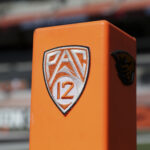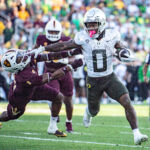Story by Jon Wilner
With 85% of its non-conference schedule complete, the Pac-12 has two consequential victories and little else to show for three weeks of effort.
UCLA’s takedown of LSU propped up the conference, and Oregon’s breakthrough win at Ohio State carved a desperately needed path to the playoff.
But beyond those results — two out of the 23 non-conference games played thus far — the Pac-12’s collective performance has reignited the narrative that it’s a step behind the other Power Five conferences:
— The Pac-12 has one undefeated team (Oregon). The Big Ten, Big 12 and SEC each have six.
— The Pac-12 has two losses to FCS opponents (Montana and NAU). The ACC has one (Jacksonville State). The Big Ten, Big 12 and SEC have none.
— The Pac-12 has a 3-6 record against other Power Five leagues. The ACC is worse (3-8), but the Big Ten, Big 12 and SEC are all above .500 in the head-to-head duels.
Perhaps the most telling data point of all is performance against Group of Five opponents: The Pac-12 is the only Power Five league with more losses than wins.
In fact, it has as many losses to the Group of Five (eight) as the Big 12 (one), Big Ten (two), SEC (two) and ACC (three) combined.
Cal collapsed at home against Nevada. Washington State did the same against Utah State. Three teams have lost to Brigham Young. Two have lost to San Diego State.
In Week One, the North division lost five non-conference games.
In Week Three, the South did the same.
“No question, it has been a couple of bad weeks. But I think it’s too soon for broad pronouncements of where it’s going to end up,’’ said Rod Gilmore, the ESPN analyst and former Stanford player.
“Look at the ACC. We’re seeing struggles at other places. It’s not just a Pac-12 issue. But I don’t think the conference will ever change the national perception. Even if it does well, people will say they’re not sold. The proof will be if the Pac-12 finally gets a team in the playoff — and how it performs there.”
Some disagree with the notion that the Pac-12 is no better than it was before the pandemic, when it regularly lost games on the big stage, was eliminated from the playoff race before November and was the object of ridicule from Clemson to Norman and all points between.
“To say it’s the lowest of the Power Five is a joke of a take,’’ Pac-12 Networks analyst Yogi Roth said. “What’s the reality? The league is in a healthy spot.
“People say it’s just like it was. It’s not like it was. The Oregon win is going to carry. And you have to take all the losses individually.”
But taking each loss individually for the Pac-12 requires the same standard be applied to every Power Five conference — and then you end up in the same place:
With the Pac-12 having fewer undefeated teams, more FCS humiliations and more Group of Five losses than its peers.
“Chip Kelly made a great point after UCLA beat LSU,’’ said Petros Papadakis, the Fox Sports analyst and former USC running back. “He said, ‘The Pac-12 didn’t beat the SEC; it was just us against them.’
“Every game is a moment. You can break down all the reasons for all the results and drive yourself crazy.”
Some of the reasons have been apparent for years:
— Many of the top prospects on the West Coast are signing with blue blood programs in other regions.
— Pac-12 programs don’t have the revenue base to build up football infrastructure and pay top-tier salaries for head coaches and coordinators.
— Pac-12 teams lack the size and talent on the lines of scrimmage to compete with the best in the land (although Oregon and UCLA offered compelling counter-arguments).
But the results over the first three weeks of the 2021 season aren’t easily explained by the traditional narratives. The issue carries an added layer of complexity.
“Some of it’s bad luck, and some of it’s from playing good teams,” said Pac-12 Networks analyst Nigel Burton, the former Washington safety and Oregon State assistant coach. “And some of it, I don’t know how to explain.”
Here are three issues specific to 2021 worth considering:
Quarterback Chaos
Nobody expected this to be a glorious year for quarterbacks — there are no Sam Darnolds, Josh Rosens or Justin Herberts in the conference.
But substandard play has ravaged Arizona, Colorado, Stanford, Washington, Oregon State and Utah at various points over the first three weeks.
“Any number of places, you look around and there’s a quarterback issue,” Gilmore said.
The most impactful performance by a quarterback came in Week Two, when Anthony Brown’s steady hand and efficiency led Oregon to five touchdowns — and zero turnovers — in the crucible of Ohio Stadium.
But Brown is in his sixth year of major college football and his second under Oregon playcaller Joe Moorhead. Only three other teams (USC, UCLA and Arizona State) opened the season with starting quarterbacks who are upperclassmen and have at least one year in the system.
The head coaches and offensive coordinators bear some responsibility for the erratic play, as well. Utah, Stanford and Oregon State have already benched their Week One starters because of poor play — Arizona might, as well — which calls the original decisions into question.
And at times, the playcalling has been mind-boggling.
“Some teams have serious offensive deficiencies,” Papadakis said. “Why? Some of it is coaching-related.”
Meanwhile, Washington State, USC and Colorado have experienced injuries at the position that impact both performance and available options.
“I don’t think the Pac-12 struggling at the quarterback position should be the narrative for the losses,” Roth said. “It’s a combination of a bunch of stuff. Every other league is saying that, too.”
Indeed, the transfer portal has made management of the position extremely challenging for coaches across the Power Five. They can’t get caught short but are unable to keep every quarterback happy all the time and, as a result, run the risk of losing players at any point in the season.
Brewer left Utah this week after getting benched in favor of Cameron Rising.
“It’s a different animal now,” Burton said. “The high school guys are better prepared to play right away, and you have all these guys transferring.”
Like everything else, the issue ultimately hinges on recruiting, evaluation and development. Plenty has been written and uttered about all the five-star quarterbacks who left the West Coast for perennial playoff contenders like Oklahoma, Ohio State, Georgia, Alabama and Clemson.
But Mississippi has one: Matt Corral, the current Heisman Trophy betting favorite, played for Long Beach Poly.
So does Nevada: Carson Strong, a possible first-round draft pick, is from Northern California.
And so does Fresno State: Jake Haener, whose incredible performance Saturday night toppled UCLA, is from the Bay Area, began his career at Washington, then left when it became clear he would never start for the Huskies.
COVID’s Impact
Papadakis has a unique perspective on the West Coast football scene. He lives in Los Angeles and, in his role for Fox, handles color commentary for Pac-12 and Mountain West games.
He participates in production meetings with head coaches and coordinators from both conferences.
When a recent discussion turned to the Mountain West’s head-to-head success against the Pac-12 — five victories in three weeks — Papadakis skipped over the usual topics of quarterback play, questionable coaching and late-game blunders.
“Whenever you start training camp, the defense is always ahead of the offense. Coaches always say that,” he said. “And our offenses in the Pac-12 are behind. Why? Maybe because we didn’t really have a season last year.
“Why is the Mountain West beating us? They pulled off a season during COVID, and they look better on offense now.”
In general, Mountain West teams started practice earlier and played more games than their Pac-12 counterparts last year.
In fact, Pac-12 teams had less total time on the field — from offseason workouts to training camp to competition — than their peers across the country.
While many teams in the ACC, Big 12 and SEC played 10 games, most in the Pac-12 played half that total.
And what of Brigham Young, which has beaten Arizona, ASU and Utah in successive weeks?
The Cougars played 12 games last year and started training camp in early August — a week before the Pac-12 began its two-month shutdown.
“I’m not blaming anybody for the circumstances,” Papadakis said. “But Pac-12 teams didn’t play enough season or practice enough.”
Blocking schemes and aerial efficiency aren’t the only areas that require repetition in practice and games.
“There is more poor tackling than I have seen, and I think it’s because they cut back on practices,’’ said Gilmore, who played defensive back for Stanford. “That’s where it shows up first and foremost.”
Apples to Oranges
With the exception of the victories over LSU and Ohio State, the Pac-12’s ledger is gruesome — and it looks even worse when compared to its Power Five peers.
Winning percentage against Group of Five opponents:
Big 12: 90.9%
SEC: 88.2%
Big Ten: 83.3%
ACC: 76.9%
Pac-12: 42.8%
But that comparison isn’t entirely fair, because not all Group of Five leagues (or teams) are created equal.
Pac-12 schedules are loaded with Mountain West teams and BYU. Their equivalent in talent in the eastern half of the country is the American Athletic Conference.
Except the ACC, Big 12, Big Ten and SEC play very few games against the American. Instead, they load up on lesser Group of Five leagues like the Sun Belt, Conference USA and the Mid-American.
Yet that disparity in strength of schedule is hidden in the oft-cited metrics like record and winning percentage against the Group of Five.
“The West Coast has a ton of great players and not a ton of schools,” said Burton, who was Nevada’s defensive coordinator during Colin Kaepernick’s career in Reno.
Of the 65 programs in the Group of Five, only 22% are located in the western half of the country.
“The Mountain West has Pac-12 players running around because those kids don’t want to leave the West Coast and there aren’t any other options. They’re like, ‘Should I play at Memphis or USF, or just stay home and play for San Diego State?’
“The Mountain West is not the Sun Belt. It’s not Conference USA.”
In fact, the Mountain West has produced 50% more NFL Draft selections than each of the Sun Belt, MAC and CUSA over the past five years, according to College Football News.
Sure, the talent in the American is better, but the 52 teams in the other Power Five leagues have played 13 games against the American this season.
The Pac-12 has played 13 against the Mountain West and BYU.
Does that difference in schedules, when combined with the COVID factor, fully account for the conference’s performance in 2021? Absolutely not. It only gets us halfway to a satisfactory explanation.
The Pac-12 has lost games to the Group of Five that it shouldn’t lose — of that, there is no dispute.
And the collapses by Washington and Arizona against FCS opponents are “inexcusable,” Roth said.
But swap a few losses to the top teams in the Mountain West and BYU for a few wins against the bottom rung of the Sun Belt or CUSA, and the Pac-12’s metrics would look better in comparison to its peers.
It might even have a few more undefeated teams.
Support the Hotline: Receive three months of unlimited access for just 99 cents. Yep, that’s 99 cents for 90 days, with the option to cancel anytime. Details are here, and thanks for your support.
*** Send suggestions, comments and tips (confidentiality guaranteed) to pac12hotline@bayareanewsgroup.com or call 408-920-5716
*** Follow me on Twitter: @WilnerHotline
*** Pac-12 Hotline is not endorsed or sponsored by the Pac-12 Conference, and the views expressed herein do not necessarily reflect the views of the Conference.
Related posts:

(AP Photo/Marcio Jose Sanchez)
Wilner Hotline: Arizona State Under the Microscope vs BYU, Week Three Preview
(AP Photo/Amanda Loman)
Wilner Pac-12 rewind: USC escapes, Top-25 ballot, riveting Week 6 as a showdown awaits
(AP Photo/Marcio Jose Sanchez)
Business of Sports-Pac-12 collapse: Pac-12 Network production studio an asset or liability? Pac-12 bowl selections: UW’s daunting assignment, major letdown for Oregon, Arizona wins again, good news for OSU and more
Pac-12 bowl selections: UW’s daunting assignment, major letdown for Oregon, Arizona wins again, good news for OSU and more

